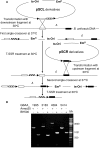Genome engineering in Bacillus anthracis using tyrosine site-specific recombinases
- PMID: 28829806
- PMCID: PMC5567495
- DOI: 10.1371/journal.pone.0183346
Genome engineering in Bacillus anthracis using tyrosine site-specific recombinases
Abstract
Tyrosine site-specific recombinases (T-SSR) are polynucleotidyltransferases that catalyze cutting and joining reactions between short specific DNA sequences. We developed three systems for performing genetic modifications in Bacillus anthracis that use T-SSR and their cognate target sequences, namely Escherichia coli bacteriophage P1 Cre-loxP, Saccharomyces cerevisiae Flp-FRT, and a newly discovered IntXO-PSL system from B. anthracis plasmid pXO1. All three tyrosine recombinase systems were used for creation of a B. anthracis sporulation-deficient, plasmid-free strain deleted for ten proteases which had been identified by proteomic analysis as being present in the B. anthracis secretome. This strain was used successfully for production of various recombinant proteins, including several that are candidates for inclusion in improved anthrax vaccines. These genetic tools developed for DNA manipulation in B. anthracis were also used for construction of strains having chromosomal insertions of 1, 2, or 3 adjacent atxA genes. AtxA is a B. anthracis global transcriptional regulator required for the response of B. anthracis virulence factor genes to bicarbonate. We found a positive correlation between the atxA copy number and the expression level of the pagA gene encoding B. anthracis protective antigen, when strains were grown in a carbon dioxide atmosphere. These results demonstrate that the three T-SSR systems described here provide effective tools for B. anthracis genome editing. These T-SSR systems may also be applicable to other prokaryotes and to eukaryotes.
Conflict of interest statement
Figures




References
-
- Buchholz F. Engineering DNA processing enzymes for the postgenomic era. Curr Opin Biotechnol. 2009;20(4):383–9. doi: 10.1016/j.copbio.2009.07.005 - DOI - PubMed
-
- Meinke G, Bohm A, Hauber J, Pisabarro MT, Buchholz F. Cre recombinase and other tyrosine recombinases. Chem Rev. 2016. - PubMed
-
- Grindley ND, Whiteson KL, Rice PA. Mechanisms of site-specific recombination. Annu Rev Biochem. 2006;75:567–605. doi: 10.1146/annurev.biochem.73.011303.073908 - DOI - PubMed
-
- Pomerantsev AP, Sitaraman R, Galloway CR, Kivovich V, Leppla SH. Genome engineering in Bacillus anthracis using Cre recombinase. Infect Immun. 2006;74(1):682–93. doi: 10.1128/IAI.74.1.682-693.2006 - DOI - PMC - PubMed
MeSH terms
Substances
Grants and funding
LinkOut - more resources
Full Text Sources
Other Literature Sources
Miscellaneous

